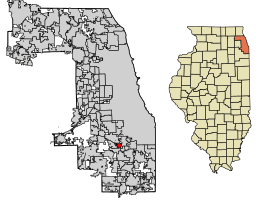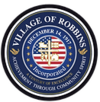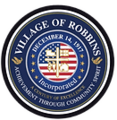Robbins, Illinois facts for kids
Quick facts for kids
Robbins, Illinois
|
||
|---|---|---|
|
||

Location of Robbins in Cook County, Illinois.
|
||
| Country | United States | |
| State | Illinois | |
| County | Cook | |
| Townships | Bremen, Worth | |
| Incorporated | 1917 | |
| Area | ||
| • Total | 1.45 sq mi (3.75 km2) | |
| • Land | 1.45 sq mi (3.75 km2) | |
| • Water | 0.00 sq mi (0.00 km2) 0% | |
| Population
(2020)
|
||
| • Total | 4,629 | |
| • Density | 3,194.62/sq mi (1,233.52/km2) | |
| Standard of living (2007-11) | ||
| • Per capita income | $13,089 | |
| • Median home value | $77,600 | |
| ZIP code(s) |
60472
|
|
| Area code(s) | 708/464 | |
| Geocode | 64616 | |
| FIPS code | 17-64616 | |
Robbins is a village located southwest of Chicago in Cook County, Illinois, United States. In 2020, about 4,629 people lived there. It is special because it is one of the oldest towns in the northern U.S. to be officially run by African Americans. Robbins was also home to the country's first airport owned by Black people, called Robbins Airport.
Contents
History of Robbins
Robbins became an official village on December 14, 1917. It was named after Eugene S. Robbins, who was a real estate developer. He helped plan out the first neighborhoods in the village.
The person who founded Robbins and became its first mayor was Thomas J. Kellar. He once said that people came to Robbins because they wanted to escape the crowded city. They wanted a place where they could raise chickens, grow gardens, and feel more free. Robbins was the only town in the northern U.S. that was completely governed by African Americans.
Thomas J. Kellar School in Robbins was named in his honor. It first opened its doors to students in 1954. After Robbins became a village, it became a popular place for Black Chicagoans to visit. They would come for picnics and enjoy the nightclubs on summer weekends.
Geography of Robbins
Robbins is a small village. According to information from 2010, it covers an area of about 1.45 square miles (3.75 square kilometers). All of this area is land.
People of Robbins
| Historical population | |||
|---|---|---|---|
| Census | Pop. | %± | |
| 1920 | 431 | — | |
| 1930 | 753 | 74.7% | |
| 1940 | 1,349 | 79.2% | |
| 1950 | 4,766 | 253.3% | |
| 1960 | 7,511 | 57.6% | |
| 1970 | 9,641 | 28.4% | |
| 1980 | 8,853 | −8.2% | |
| 1990 | 7,498 | −15.3% | |
| 2000 | 6,635 | −11.5% | |
| 2010 | 5,337 | −19.6% | |
| 2020 | 4,629 | −13.3% | |
| U.S. Decennial Census 2010 2020 |
|||
In 2020, there were 4,629 people living in Robbins. Most of the people in the village, about 84.77%, were African American. There were also people of White, Native American, Asian, and other backgrounds. About 7.47% of the population identified as Hispanic or Latino.
There were 1,551 households in Robbins. About 29.3% of these households had children under 18 living with them. The average household had about 3 to 4 people.
The people in Robbins are of different ages. About 20.9% of the population was under 18 years old. About 15.9% of the people were 65 years old or older. The average age in the village was 35 years old.
Getting Around Robbins
Robbins has several ways for people to travel.
- Train: There is a train station in Robbins. It is part of Metra's Rock Island District line, which is a commuter train service.
- Buses: Two Pace bus routes serve Robbins. These are routes 359 (Robbins/South Kedzie Avenue) and 385 (87th/111th/127th).
- Highways: Interstate 294 runs through Robbins. While there are no exits directly in the village, you can reach Interstates 57 and 294 with a short drive.
- Airports: Midway International Airport is about a 25-30 minute drive away. O'Hare International Airport is also reachable, about 30-45 minutes away.
Robbins Airport: A Special Place
Robbins was once home to the Robbins Airport. This airport was very important because it was the first in the United States to be owned and run by African Americans. It operated from 1930 to 1933.
This airport had the only flight school at the time where African Americans could learn to be pilots. It even served as an inspiration for the famous Tuskegee Airmen Program during World War II. Many amazing African American pilots flew from this airport.
Sadly, a tornado destroyed the airport and its hangar in 1933. The flight school then moved to another airport in Chicago. Many of the instructors from the Robbins flight school later joined the Tuskegee Airmen Program. One important instructor was John C. Robinson. He became the Supreme Commander of the Ethiopian Air Force when Italy invaded Ethiopia in 1935. The brave actions of these pilots have been recognized by the Smithsonian Institution's Air and Space Museum.
Education in Robbins
Students in Robbins are served by the Posen-Robbins School District 143½.
Famous People from Robbins
Many notable people have connections to Robbins:
- Jan Bradley – A soul singer known for "Mama Didn't Lie." She grew up in Robbins.
- Bessie Coleman – A pioneering aviator who helped start the Robbins Airport.
- S. B. Fuller – A successful businessman who founded Fuller Products Company.
- Thomas J. Kellar – The founding mayor of Robbins.
- James Loving – A wide receiver who played for the Philadelphia Eagles.
- Joe Montgomery – A running back who played for the New York Giants and Carolina Panthers. He was born in Robbins.
- Nichelle Nichols – An actress famous for playing Uhura in Star Trek. She was born in Robbins.
- Keke Palmer – A well-known actress, TV host, and singer. She grew up in Robbins.
- Jim Smith – A wide receiver for the Pittsburgh Steelers who won two Super Bowls. He grew up in Robbins.
- Dwyane Wade – A famous former NBA basketball player who won three NBA championships. He grew up in Robbins.
Images for kids
See also
 In Spanish: Robbins (Illinois) para niños
In Spanish: Robbins (Illinois) para niños







